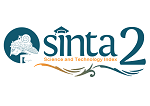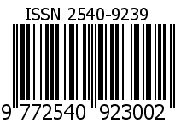Development of a responsive web-based digital library for geography education students
Abstract
A responsive web-based digital library is an application built with web technology to allow users to access digital collections via the Internet. Most digital libraries have not adequately addressed the need for self-directed learning for students, so students' access to educational resources is still limited. This study aimed to determine the development of a responsive web-based digital library for geography education students through an analysis of the identification of the planning process for a responsive web-based digital library, a feasibility evaluation by experts, and an assessment of geography education students’ responses. The research method used a Research and Development strategy through the 4D model (define, design, develop, and disseminate). The result was that the research plan involved needs analysis for students. The system design used case and activity diagrams and prototype development validated by experts. Expert evaluation on usability, navigation, graphic design, content, and compatibility falls in the 62.50% < score ≤ 81.25% range, indicating feasibility. The study result was a research plan involving needs analysis for geography education students. The system design used case and activity diagrams and the development of a prototype validated by experts. Expert evaluations on usability, navigation, graphic design, content, and compatibility were in the range of 62.50% < score ≤ 81.25%, indicating feasibility. Students' responses showed that the highest percentages were visual communication (80.73%, very good), usability (76.03%, good), and device compatibility (78.18%, good). In conclusion, this study provides significant contributions to supporting self-directed learning by providing easier access to academic resources for geography education students.
Keywords
Full Text:
PDFReferences
Abidin, Z., Zulaikha, I., Wicaksono, D. W., Umam, K., & Aulia, A. F. (2021). Development of postgraduate school’s digital library as a repository of digital collections. Journal of Physics: Conference Series, 1918(4), 042019. https://doi.org/10.1088/1742-6596/1918/4/042019
Anugrah, D. A., & Kurniadi, D. (2015). Rancang bangun aplikasi e-library berbasis web dengan teknologi responsive. Jurnal Algoritma, 14(2), 437–442. https://doi.org/10.33364/algoritma/v.14-2.437
Armen. (2018). Pustakawan sebagai pelayanan informasi bagi pemustaka. Jurnal Imam Bonjol: Kajian Ilmu Informasi Dan Perpustakaan, 2(2), 12–23. https://scholar.uinib.ac.id/id/eprint/1146/1/33-64-1-SM.pdf
Arum, A. P., & Marfianti, Y. (2021). Pengembangan perpustakaan digital untuk mempermudah akses informasi. Information Science and Library, 2(2), 92. https://doi.org/10.26623/jisl.v2i2.3290
Belvedere, V., Grando, A., & Bielli, P. (2013). A quantitative investigation of the role of information and communication technologies in the implementation of a product-service system. International Journal of Production Research, 51(2), 410–426. https://doi.org/10.1080/00207543.2011.648278
Brewer, L., Rick, H., & Grondin, K. A. (2017). Improving digital library experiences and support with online research guides. Online Learning, 21(3), 135–150. https://doi.org/10.24059/olj.v21i3.1237
Caffrey, C., Lee, H., Withorn, T., Clarke, M., Castañeda, A., Macomber, K., Jackson, K. M., Eslami, J., Haas, A., Philo, T., Galoozis, E., Vermeer, W., Andora, A., & Kohn, K. P. (2022). Library instruction and information literacy 2021. Reference Services Review, 50(3/4), 271–355. https://doi.org/10.1108/RSR-09-2022-0035
Fitria, E., Sabandi, A., Irsyad, I., Al Kadri, H., & Khomarudin, A. N. (2023). Digital library development at MAN 1 Bukittinggi as an accessibility convenience support for users. JURTEKSI (Jurnal Teknologi Dan Sistem Informasi), 9(2), 133–140. https://doi.org/10.33330/jurteksi.v9i2.2013
Fredyana, C. A., & Dewanto. (2016). Pengembangan media pembelajaran berbasis android pada mata pelajaran teknologi dasar otomotif untuk kelas X SMK Negeri 3 Buduran - Sidoarjo. Jurnal Pendidikan Teknik Mesin, 5(3), 40–46. https://media.neliti.com/media/publications/250480-pengembangan-media-pembelajaran-berbasis-41f8e116.pdf
Gonçalves, M. A., Moreira, B. L., Fox, E. A., & Watson, L. T. (2007). “What is a good digital library?” – A quality model for digital libraries. Information Processing & Management, 43(5), 1416–1437. https://doi.org/10.1016/j.ipm.2006.11.010
Hamad, F., Al-Fadel, M., & Shehata, A. M. K. (2024). The level of digital competencies for the provision of smart information service at academic libraries in Jordan. Global Knowledge, Memory and Communication, 73(4/5), 614–633. https://doi.org/10.1108/GKMC-06-2022-0131
Horton, B. L., Morgan, D. M., Momin, N., Zagorulya, M., Torres-Mejia, E., Bhandarkar, V., Wittrup, K. D., Love, J. C., & Spranger, S. (2021). Lack of CD8 + T cell effector differentiation during priming mediates checkpoint blockade resistance in non–small cell lung cancer. Science Immunology, 6(64). https://doi.org/10.1126/sciimmunol.abi8800
Kumaran, V. S., & Latha, R. (2023). Towards personal learning environment by enhancing adaptive access to digital library using ontology-supported collaborative filtering. Library Hi Tech, 41(6), 1658–1675. https://doi.org/10.1108/LHT-12-2021-0433
Listyorini, T., & Iqbal, M. (2015). Perancangan pengembangan digital library berbasis web responsive. Simetris: Jurnal Teknik Mesin, Elektro Dan Ilmu Komputer, 6(1), 69. https://doi.org/10.24176/simet.v6i1.238
Lu, S. S., Tian, R., & Chiu, D. K. W. (2024). Why do people not attend public library programs in the current digital age? A mixed method study in Hong Kong. Library Hi Tech, 42(4), 1237–1265. https://doi.org/10.1108/LHT-04-2022-0217
Mamabolo, M. J., & Durodolu, O. O. (2023). Rural accessibility to digital libraries: Requirements and challenges. Digital Library Perspectives, 39(4), 551–570. https://doi.org/10.1108/DLP-04-2023-0025
Mestre, J.-L. Z. i. (2024). Project for the introduction of a materials library within a conventional library of a university degree in architecture. 10th International Conference on Higher Education Advances (HEAd’24), 1–8. https://doi.org/10.4995/HEAd24.2024.17083
Nielsen, J. (2012, January 3). Usability 101: Introduction to usability. Nielsen Norman Group. https://www.nngroup.com/articles/usability-101-introduction-to-usability/
Nooji, M., N., L. K. V., R., S. H., R., S. H., Duragannavar, G. F., & Nataraj, S. (2023). Impact of digital library resources on higher education student development. Journal of Survey in Fisheries Sciences, 10(3S), 5766–5772. https://sifisheriessciences.com/journal/index.php/journal/article/view/1977/2032
Park, N., Roman, R., Lee, S., & Chung, J. E. (2009). User acceptance of a digital library system in developing countries: An application of the Technology Acceptance Model. International Journal of Information Management, 29(3), 196–209. https://doi.org/10.1016/j.ijinfomgt.2008.07.001
Presiden Republik Indonesia (2007). Undang-undang No. 43 Tahun 2007 Tentang Perpustakaan, Pub. L. No. 01 November 2007. Lembaran Negara Republik Indonesia Tahun 2007 Nomor 129. Jakarta. https://peraturan.bpk.go.id/Details/39968/uu-no-43-tahun-2007
Presiden Republik Indonesia (2008). Undang-undang Nomor 14 Tahun 2008 tentang Keterbukaan Informasi Publik, Pub. L. No. 30 April 2008. Lembaran Negara Republik Indonesia Tahun 2008 Nomor 61. Jakarta. https://peraturan.bpk.go.id/Details/39047/uu-no-14-tahun-2008
Rosman, M. R. M., Ismail, M. N., & Masrek, M. N. (2022). Development and validation of a tool for measuring digital library engagement. International Journal of Electrical and Computer Engineering (IJECE), 12(4), 4146–4154. https://doi.org/10.11591/ijece.v12i4.pp4146-4154
Schall, A. (2014). Information architecture and web navigation. In Eye Tracking in User Experience Design (pp. 139–162). Elsevier. https://doi.org/10.1016/B978-0-12-408138-3.00006-6
Sugiyono. (2017). Metode penelitian pendidikan pendekatan kuantitatif, kualitatif dan R&D. Alfabeta.
Sujood, S., S., Nafees, S., & Bano, N. (2023). User's intention towards the use of digital libraries: A post COVID-19 scenario. Digital Library Perspectives, 39(4), 470–495. https://doi.org/10.1108/DLP-12-2022-0105
Sunu, I. G. K. A. (2022). Digital library in education administration management. Jurnal Penelitian Dan Pengembangan Pendidikan, 6(3), 349–357. https://doi.org/10.23887/jppp.v6i3.53019
Tella, A., Ajani, Y. A., & Ailaku, U. V. (2023). Libraries in the metaverse: The need for meta literacy for digital librarians and digital age library users. Library Hi Tech News, 40(8), 14–18. https://doi.org/10.1108/LHTN-06-2023-0094
Tian, X., & Martin, B. (2011). Impacting forces on Facebook business models development. Publishing Research Quarterly, 27(3), 230–246. https://doi.org/10.1007/s12109-011-9229-0
Ubaidah, S., & Widjaya, S. (2022). Pengaruh fasilitas perpustakaan dan kenyamanan terhadap minat baca pengunjung di perpustakaan arsip dan dokumentasi di Bangkalan. Eco-Socio: Jurnal Ilmu Dan Pendidikan Ekonomi, 6(1), 37–44. https://doi.org/10.31597/ecs.v6i1.809
Wang, H., & Ding, J. (2022). Development strategy of intelligent digital library without human service in the era of “internet +.” Computational Intelligence and Neuroscience, 2022(1), 1–11. https://doi.org/10.1155/2022/7892738
Wen, C., & Zhang, J. (2015). 10.1109/TE.2014.2363627. IEEE Transactions on Education, 58(3), 203–207. https://doi.org/10.1109/TE.2014.2363627
Yan, Y., Zha, X., Zhang, J., & Hou, X. (2014). Comparing digital libraries with virtual communities from the perspective of equality. Library Hi Tech, 32(1), 173–189. https://doi.org/10.1108/LHT-04-2013-0042
Yaqin, M. A. (2022). Strategy of library development towards digital library. Khatulistiwa: Jurnal Pendidikan Dan Sosial Humaniora, 2(2), 52–69. https://doi.org/10.55606/khatulistiwa.v2i2.417
Youssef, L. A., & Khalifa, N. M. (2024). The digital library of Arab children's culture for sustainable development ( DLACSD ). Journal of Humanities and Applied Social Sciences. https://doi.org/10.1108/JHASS-05-2024-0069
DOI: https://doi.org/10.24198/jkip.v12i2.53811
Refbacks
- There are currently no refbacks.
Copyright (c) 2024 Author(s)

This work is licensed under a Creative Commons Attribution-ShareAlike 4.0 International License.
Jurnal Kajian Informasi & Perpustakaan Indexed by:
Jurnal Kajian Informasi & Perpustakaan
Program Studi Perpustakaan dan Sains Informasi d.h. Program Studi Ilmu Perpustakaan
Fakultas Ilmu Komunikasi, Universitas Padjadjaran
Jl. Raya Bandung-Sumedang Km. 21 Jatinangor, Sumedang, Indonesia 45363
WA: +62 877-1860-4022 (Risa Nurisani)
Telepon: +62227796954
Faksimile: +62227794122
email: jkip.fikom@unpad.ac.id
Jurnal Kajian Informasi & Perpustakaan is licensed under a Creative Commons Attribution-ShareAlike 4.0 International License
Jurnal Kajian Informasi & Perpustakaan supervised by:












2.png)
.png)



